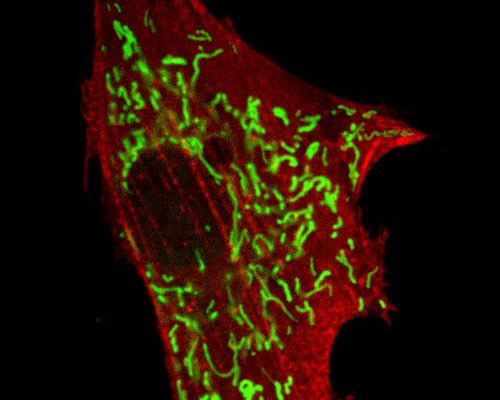Grey Fox Lung Cells with mEmerald-Mito and mApple-α-Actinin

The grey fox hunts individually and is mostly omnivorous, in contrast to the Red Fox. It regularly preys upon the Eastern Cottontail rabbit, one of the most common species of rabbit in North America. The grey fox will also gladly catch shrews, voles, and birds. Additionally, it adds whatever fruits are readily available to its diet.
The number of mitochondria present in a cell is generally related to the specific level of cellular metabolic activity. Cells with greater energy requirements, therefore, typically contain larger amounts of mitochondria than other cells. Each mitochondrion ranges in size between about 1 to 10 micrometers in length, but microscopic examination reveals that the organelles are often found in dynamic chains, networks, or other formations. Mitochondrial movement appears to be closely associated with the intracellular microtubule network.
Mitochondrial dynamics in relation to the actin cytoskeleton are visualized in the digital video sequence presented in this section. Mitochondria were highlighted with mEmerald fused to a mitochondrial targeting signal and microfilaments and other actin-rich structures in the cell were tagged with mApple fused to alpha-actinin, an actin-binding protein. mEmerald exhibits peak excitation at 487 nanometers and peak emission at 509 nanometers, while the mRFP1 derivative mApple experiences excitation and emission maxima at 568 and 592 nanometers, respectively.



